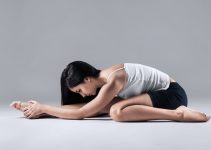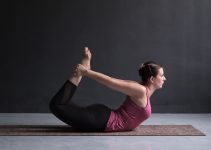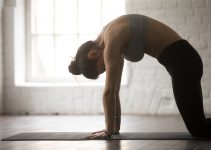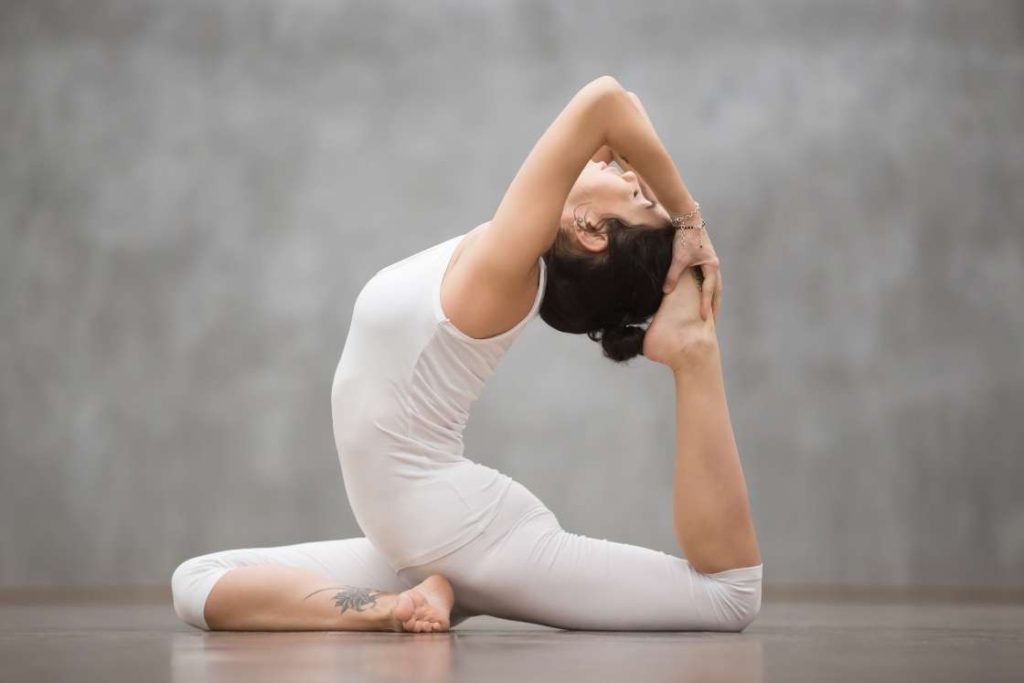
| Sanskrit Pronunciation | Eka Pada Rajakapotasana (eh-kuh pah-dah RAH-juh kah-po-TAHS-ah-nuh) |
| Meaning | Eka = one / Pada = foot / Raja = King / Kapota = pigeon asana = pose |
| Pose Type | Seated Back bending pose |
| Pose Level | Advance pose |
| Anatomy | Back muscles, hips, hamstrings, inner thigh, calves, neck, pelvis, knees, and groin |
| Other Names | One-footed King Pigeon Pose, Pigeon King Pose, Eka Pada Rajakapotasana, One-legged King Pigeon Pose. |
Eka Pada Rajakapotasana is an advanced level seated back bending asana, which is one of the effective poses for the hip opening poses. It is also helpful in improving the flexibility of the groin and pelvic region. Moreover, it works upon the twisting of the torso as well that further assist in the poses requires extreme flexibility.
The advancement of this posture makes it a challenging one but the objectives associated are of paramount importance. The consistent practice of Eka Pada Rajakapotasana gives a calming effect to the mind, which in turn plants the seed of positivity in the field of life to cultivate the most productive crops of Mental and Emotional values.
Eka Pada Rajakapotasana Meaning
The Eka Pada Rajakapotasana is a Sanskrit word where ‘Eka’ means ‘one’, ‘Pada’ means ‘foot’, ‘raja’ means ‘king’, ‘kapota’ means ‘pigeon’ and ‘asana’ means ‘Pose’. Therefore, this asana is known as King Pigeon Pose. The competency of this pose adds the high characteristics when it is performed by the practitioner. This is the reason it is prefixed with the title of King in its name.
Pigeon represents love, peace, and gratitude in abundance. Practitioners practicing this pose develops a sense of kindheartedness and compassion towards others by leading a cheerful life.
Apart from that, King is the supreme caretaker of his people. In Eka Pada Rajakapotasana, King signifies ‘sacrifice‘, the sacrifice of the comfort zone that has to be given by the practitioners, which further transforms the practitioner into the king of their body. So, when you sacrifice your present state you just ensure the wellbeing of your own health in the long run.
The Eka Pada Rajakapotasana is described by the two Krishnamacharya’s pupils in the 20th century, named Pattabhi Jois in his Ashtanga Vinyasa Yoga, and B.K.S Iyenger in his book Lights on Yoga.
Practice Guide
Safe and well guided practice of this asana can be done by following the below given steps.
Contraindications for Eka Pada Rajakapotasana
- Practitioners with any kind of injury in the shoulder, knee, ankle, groin, and pelvis region should avoid practicing this asana. This might be worsening regarding the present state of that body part.
- Pregnant women with later stages of pregnancy refrain themselves from performing Ek Pada Rajakapotasana. However, in the initial stages of pregnancy, one should consult any skilled yoga teacher before beginning the practice.
- Practitioners with the condition of Sciatic nerve [efn_note] Sciatic nerve https://en.wikipedia.org/wiki/Sciatic_nerve [/efn_note] should avoid touching the extremity on experiencing a sensation in that region. So, one should go slow otherwise might cause serious damage to the nerve.
Preparatory Pose
Follow theses preparatory poses before king pigeon pose;
- Virasana (Hero Pose)
- Baddha Konasana (Bound Angle Pose)
- Bhujangasana (Cobra Pose)
How to Do Eka Pada Rajakapotasana (Steps)
- Begin by coming into the tabletop position your knees are right under your hips and your hands are placed on the floor align slightly away from the shoulder.
- Now, take your right knee behind the right wrist and slide your right foot inside in a way that the heel faces the left knee. From here, slowly drop your right hip on the floor and slide your left leg back simultaneously.
- Straighten your left knee and your left leg remain straight while you look at it to settle up the pose. Afterward, exhale to lower down your torso. Then, stretch your arms in the forward direction and then back to prepare the torso.
- Now, press your fingertips into the floor to raise your torso away from the right thigh. Simultaneously, push your tailbone down in a forwarding direction along with the lengthening of the lower back.
- After that, lift up your torso up all the way through the ribcage in a manner that your sternum faces the ceiling side. Bring a slight inward curve in your neck while taking the head in the backward direction.
- Now, bend your left knee and grab it with your hand to bring it near the head to touch it. Hold the position for few seconds and then slowly leave the left foot to the floor. Bring the torso forward by straightening the head and place hands on the floor.
- Then bring your left leg on the knee and slid back your right foot by lifting up your right hips from the floor. Come into a tabletop position on four limbs and then relax.
Follow Up pose
- Supta Virasana (Reclined hero pose)
- Ardha Virasana (Reclined Half Hero)
- Ardha Matsyendrasana (Half spinal twist pose)
Precautions
Keep following precautions in mind while performing Eka Pada Rajakapotasana (king pigeon pose);
- While lifting your right knee behind your right wrist, cause your body weight to shift towards the right side. This will lay pressure on your right hand so, it is to be advised that the foundation should be firm enough to absorb the weight change.
- One should keep the left leg straight behind the body. There might remain some chances of muscle injury on the wrong placement of the leg in any direction. Therefore, one should be precautious to avoid any kind of muscular mishappenings.
- When practitioners sliding their left leg back to land their pelvis on the floor, one should focus on the positioning of the right heel. It should be directly facing the left hip and try to keep it there because disorientation might cause pressure on the right knee. Hence, perform with patience.
Beginners Tips
- Beginners might face discomfort while maintaining a stretch between the left leg straighten behind and the right leg bent in the forwarding direction. This could be the reason for tight hamstrings so one should not extend beyond the limit.
- While bending the left leg to grab it with both hands, new practitioners find it quite challenging to perform and maintain position simultaneously. This can be done easily by working on flexibility on every body part participating at that time.
- Beginners should avoid the overbending of the upper back in order to touch your left leg to the head. Try to work on your pelvis to bring the left leg closer enough that bending the upper back does not require. However, also avoid shortening the distances between your neck to avoid the injury.
Modifications
king pigeon pose can be modified by using some yoga props;
- When a practitioner is unable to place the hip on the floor, the leg bent in a forwarding direction. Then one should place a folded blanket or block under the right hip to reach the floor. Make sure that your weight should be evenly distributed on both hips.
- If practitioners can not get to the floor as they pressed their fingers while bending forward. Then one should place blocks under their forearms or under the forehead to relax in forwarding bend.
- While bringing the left leg straight behind to touch the head. Practitioners with basic practice might lose balance or find it difficult to keep the hand in that position. So, one should bind the left foot with the strap or rope to pull the left leg towards the head.
Therapeutic Benefits
- The Eka Pada Rajakapotasana is highly effective in opening the hip joint. This eases the daily work requiring hip flexibility. It also relaxes hip flexors, which ensures better conditioning of the lower body.
- The twisting and turning in this asana overcomes the urinary disorders and stimulates internal organs, which improve the overall functioning of the body from smaller to gross level.
- This asana frees up the stress, anxiety, fear by hip opening, which is being stored there due to tightening. Hence, the free movement of the hip joint promotes the emotional state of the practitioners.
Eka Pada Rajakapotasana Variations
By bringing some changes in the Eka Pada Rajakapotasana the practitioners can practice the below variations;
1. Ardha Eka Pada Rajakapotasana (Half pigeon Pose)
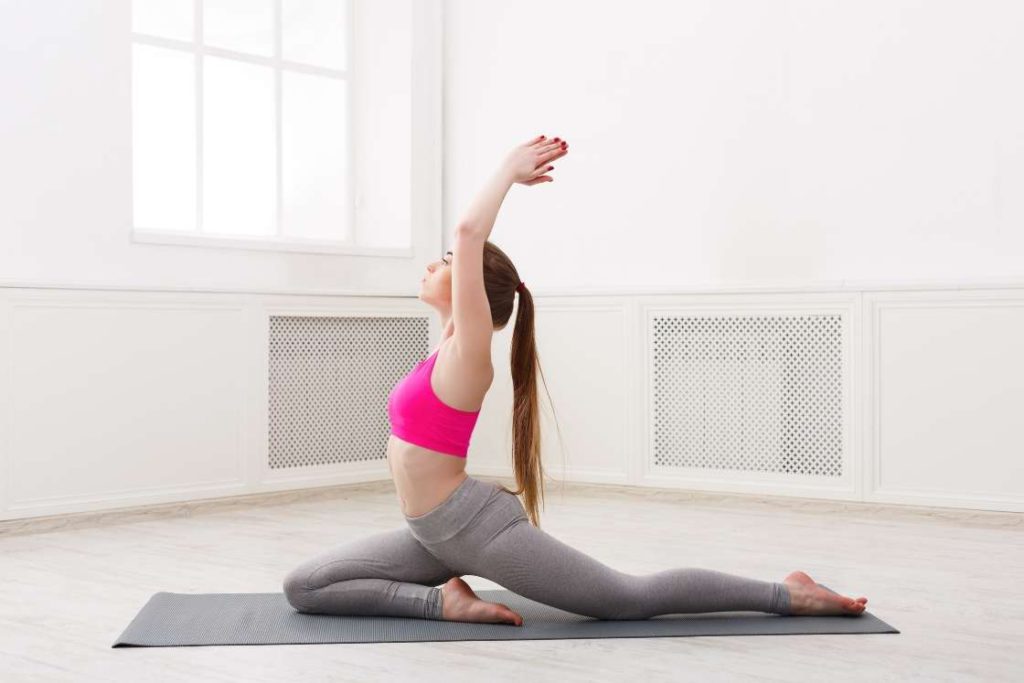
In Eka Pada Rajakapotasana, there is an angle of 90′ in the leg placed in a forwarding direction while here, the leg remains close to the inner thigh. The base pose requires bending of the left leg to touch the head whereas, in Ardha Eka Pada Rajakapotasana, the left leg remains straight and the head as well gazing in a forwarding direction.
- Begin by coming into the tabletop position. Your hands under your shoulder, knees under the hips, and head gazing down to the floor.
- Now, by slowly shifting your weight on your hands slide your right knee behind the right wrist. From here, keep the right leg as it is, then simultaneously bring the right hip to the floor and slide the left leg in the backward direction.
- Afterward, press your finger deep into the floor to settle up the base of the pose and raise your torso slowly up from here.
- Now, try to push your tailbone down and in the forward direction and straighten your left leg behind you. Bring your hand beside the hip and straight up your back here gate forward.
- After maintaining the pose come back by taking hands-on their place and bending forward. Slowly lift your right hip to bring your right knee back along with the left leg in the tabletop position and then relax.
2. Mermaid Pose
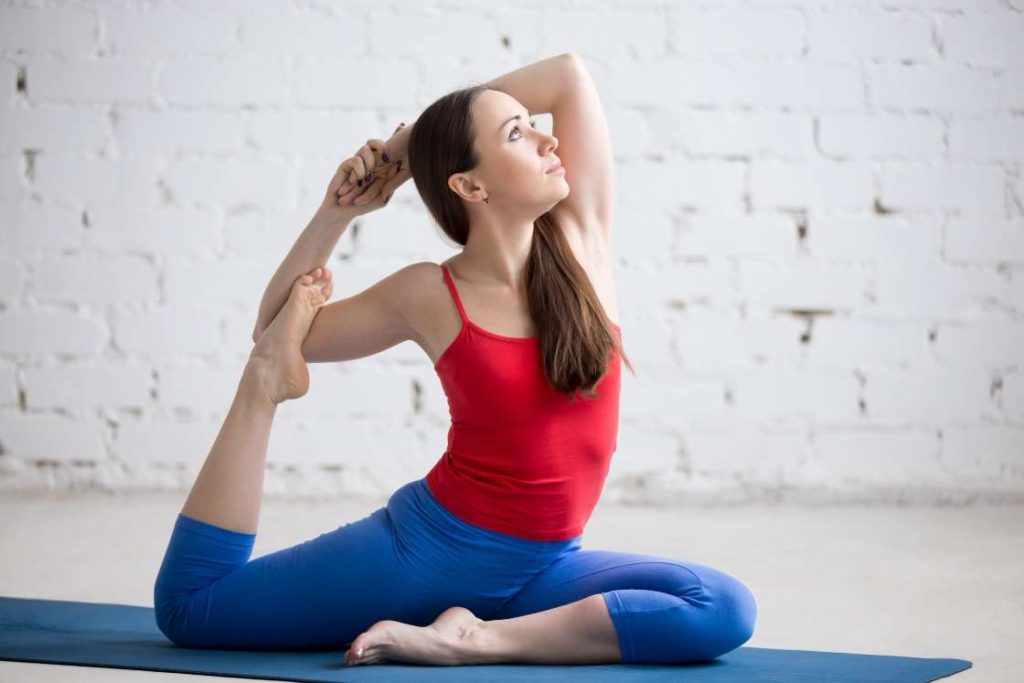
In the mermaid pose, the pelvis remains uplifted from the floor while the foot behind the body fixes the gap behind the elbow of the right hand. However, In Eka Pada Rajakapotasana the pelvis remains grounded resting on squared hips and the right foot straighten behind will be bent to touch the head with the help of both hands.
- Begin by coming into the tabletop position keep your hands under the shoulder and your knees under your hips.
- Now, slide your left knee behind the left wrist and slide your left foot inward to face the right hip exactly the same as we did in Eka Pada Rajakapotasana.
- After, slide your right leg back and drop your left hip on the floor to equalize the bodyweight on both hips. Make sure to square your hips in order to get stable into the pose.
- Now, press your fingers into the ground to raise your torso up. Now, call your left feet inside toward inner thighs and simultaneously call for the right leg to bend towards the head with the help of hands.
- As you bring the left leg to the head, raise your pelvis a little up to turn your torso up along with a slight curve in the lower back. This will decompress the spine.
- Now, grab your hand behind the shoulder and fix your right foot in the space behind the right elbow.
- From here, maintain the pose for as long as it is comfortable, then slowly unlock the feet from the gap and slowly rest the right leg to return back into the tabletop position. Then, relax.
Eka Pada Rajakapotasana Benefits
Following are some of the positive outcomes of practicing Eka Pada Rajakapotasana.
1. Acts as hip opener
The criss-cross adjustment of legs for a longer period in Eka Pada Rajakapotasana helps in the lengthening of the psoas muscles [efn_note] Psoas major muscle https://en.wikipedia.org/wiki/Psoas_major_muscle [/efn_note]. This further increases the range of motion along with the blood circulation in the hip region. Moreover, it supports the spine and lowers back muscles which help in the alleviation of back pain.
2. Strengthens Reproductive organs
The stretching in this asana makes muscles work on themselves, which requires energy and it is fulfilled by the increased blood circulation. This brings along the appropriate nutrition to feed the reproductive tissues as well. Therefore, ensures their function and ultimately strengthens them.
3. Prevents injury
According to one of the survey [efn_note] Understanding and Preventing Yoga Injuries https://meridian.allenpress.com/ijyt/article/19/1/47/138142/Understanding-and-Preventing-Yoga-Injuries [/efn_note] by International Association of Yoga Therapists (IAYT), It has been observed that the most common reason for severe injuries like the neck, lower back, wrist, knee, and shoulder area due to the poor technique or alignment or due to the advanced approach of the beginner body. However, This can be eradicated by the regular practice of Eka pada Rajakapotasana, which helps in body opening to reduce the flexibility concerning injuries.
4. Stimulates Abdominal organs
The stretching of the outer body in this asana also stretches the internal organs, which contracts and relaxes them in a subtle way. Such movements act as a detoxification activity on them, which further promotes healthy functioning and its effect on the body.
5. Reduces the Cardiovascular Risk Factor
The regular practice of Eka Pada Rajakapotasana helps in maintaining the optimum blood pressure across the body. Moreover, According to one of the study [efn_note] Yoga for the primary prevention of cardiovascular disease https://core.ac.uk/download/pdf/29189977.pdf [/efn_note] it has been found the practice of this asana lowers the High density of lipoprotein and Bad Cholesterol in the blood. These are the major cause of heart disease among middle and old aged individuals. Hence, reduces the cardiovascular [efn_note] Effects of 1-year yoga on cardiovascular risk factors in middle-aged and older adults with metabolic syndrome: a randomized trial https://dmsjournal.biomedcentral.com/articles/10.1186/s13098-015-0034-3 [/efn_note] risk factor.
6. Activates Chakras
In this pose, the spine remains activated throughout the practice, which is also the position of seven chakras. However, on practicing Eka Pada Rajakapotasana on a regular basis along with alignment and appropriate breathing technique, chakras like Vishuddha (Throat), Muladhara (Root), and Swadishthana (Sacral) become activated. Hence, improves communication, self-expression, the ability to speak personal truth, becomes a source of energy for desire, movement, pleasure, and a sense of security and stability.
Conclusion
Eka Pada Rajakapotasana is a challenging one but with ample fruitful benefits for a wide variety of health-related aspects. Practitioners can find their sense of purpose regarding their emotional, mental and physical approach.
Therefore, it would be an opportunity for an individual to dive into the diversified realm of such an amazing asana.
